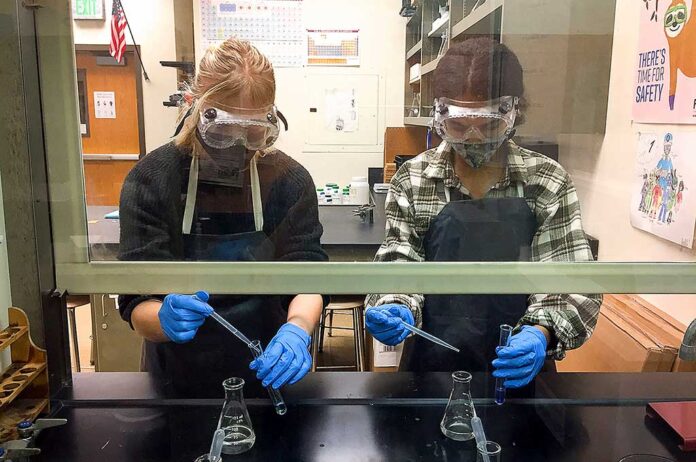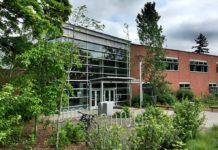
Students and teachers alike had much to adjust to following a year unlike any other. Mass uncertainty, part of a year fully online and another few months hybrid for students who opted in.
But, over the past three months, Tigard-Tualatin School District (TTSD) students have seen the classroom five days out of the week in an almost unbelievably normal schedule when compared to the 2020-21 school year, with some aspects familiar from the before-times, but others not so much.
Through teaching from behind a screen, one thing became abundantly clear to educators, forming connections and “reading the room” were near impossible. This was something cherished and necessary to many teachers.
“As a teacher, it’s pretty easy to tell if your students are ‘getting it’ when you can see them all in front of you,” said Kelsey Wahl, a chemistry teacher at Tigard High School. “Online, when I couldn’t see anyone, it was impossible.”
Wahl found that while some students took the challenge of online learning head-on or even thrived in the environment, many others did not have the best of experiences.
“Some treated online school just like in-person school by attending class every day, completing all their assignments and trying to learn all the material,” she said. “Some students didn’t get as much out of last year for various reasons. Some had responsibilities at home, others were working a lot and a few were just bored and/or unengaged.”
But, with a return to the classroom, many of the issues that had plagued the online school system seemed to melt away. The new environment resembled much of the early 2019-20 school year, and Charles F. Tigard Elementary School first-grade teacher, Lynn Marquez-Merlino, noticed this emotional impact with her 6- to 7-year-old students.
“When I’m teaching in-person, I get to see the joy, laughter, enthusiasm, the tears, the frustration, anger, happiness and excitement of each student,” she said. “In all those emotions, we learn to work through them together. We have to work really hard academically, but we have also had to work on learning ‘how to be a student’. When I was teaching online, I didn’t get to see all of those emotions.”
Over the past three months, the transition wasn’t without its hiccups. Most notably, student absences remain high, Wahl said, with teachers taking much of the brunt of the resulting work.
“Absences have been a huge issue this year,” she said. “Kids are staying home because they’re sick, or they got COVID, or they think they have COVID and are being cautious, or they’re unvaccinated and were sitting next to a kid who got COVID. I’ve had a couple students who have even had to quarantine twice because of COVID exposure.”
Last year, TTSD schools were on a four-day school week with Wednesday reserved as an independent workday for students and shortened schedules all-around. Merlino found that the transition back into a typical five-full-day school week to be exhausting, for both students and educators.
“At first, we were all tired with the five-day week,” she said. “It was quite an adjustment for me too! I wasn’t used to juggling a full workday with planning, in-person meetings, parent meetings, trainings and the list goes on and on. Somedays, I feel like my day doesn’t end until I go to bed at night. In the end, though, I wouldn’t change it.”
With such a sudden shift to online and back again over the course of a year-and-a-half, many teachers found ways to adapt their teaching methods, some of which are here to stay.
Wahl began by implementing daily class polls to gauge current understanding, with her and others implementing more technology into their methodologies including tablets, more fluid projector systems, and other online learning and testing systems.
Melissa Ruiz, the band instructor at Hazelbrook Middle School, took the 2020-21 school year to focus on individual enhancement. Students would submit recordings, and Ruiz could spend the time to critique and give feedback to her students. Although useful, she said, it was not quite the same as immediate feedback.
“When I’m teaching in-person, I am able to give direct and immediate feedback,” she said. “This was something we were able to achieve last year with students submitting individual recordings of their progress, but then the reinforcement and correction coming from me wasn’t as immediate as I’d like.”
With the move indoors, Ruiz has regained that sense of normalcy, not to mention that students can now perform as an ensemble rather than alone at their residences, bringing students ever closer to a concert setting.
“We’re able to really appreciate the beauty that takes place when musicians play live music together,” she said. “Emotion is tied to live music. Being in a space where music is created and played alongside other musicians, is something extremely special that our students are able to enjoy this school year.”
One of the biggest improvements of the return to in-person classes are the many interactions once lost to the adverse distance between peers.
“It’s been wonderful to see how students are interacting, particularly in my own classroom,” Ruiz said. “Students are going out of their way to be helpful with one another. They are encouraging, and they have so much pride in the band program as a whole.”
Wahl agreed, “the class community is so much stronger in-person because students actually talk to each other and collaborate. It’s fun to watch them work with each other and make new friends. That just didn’t happen much online. I am so happy to be back in the classroom learning with them, they make my job fun.”





















